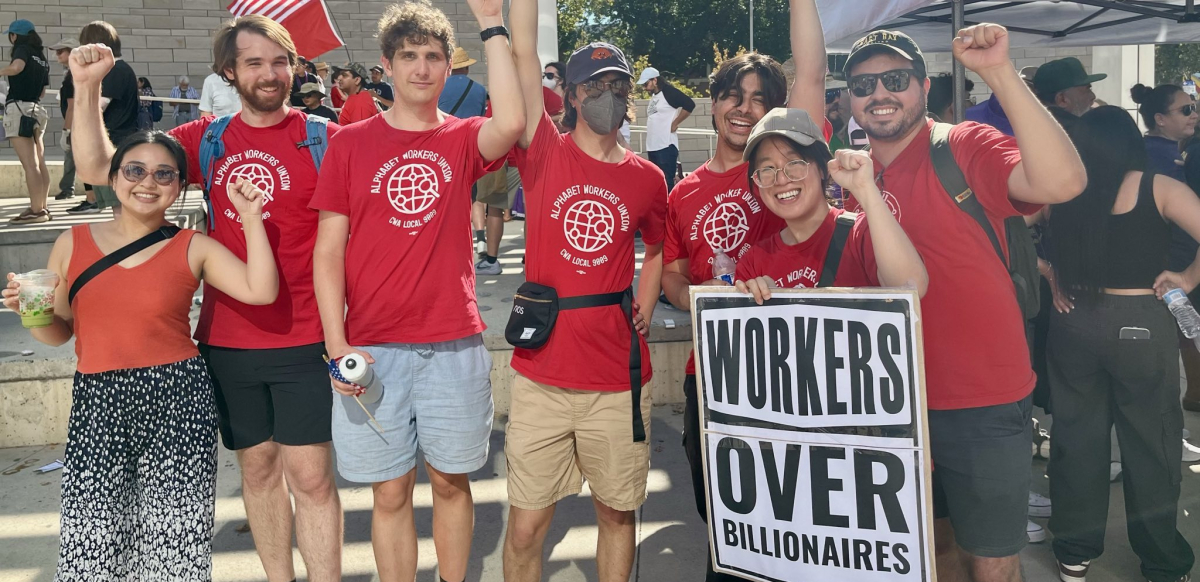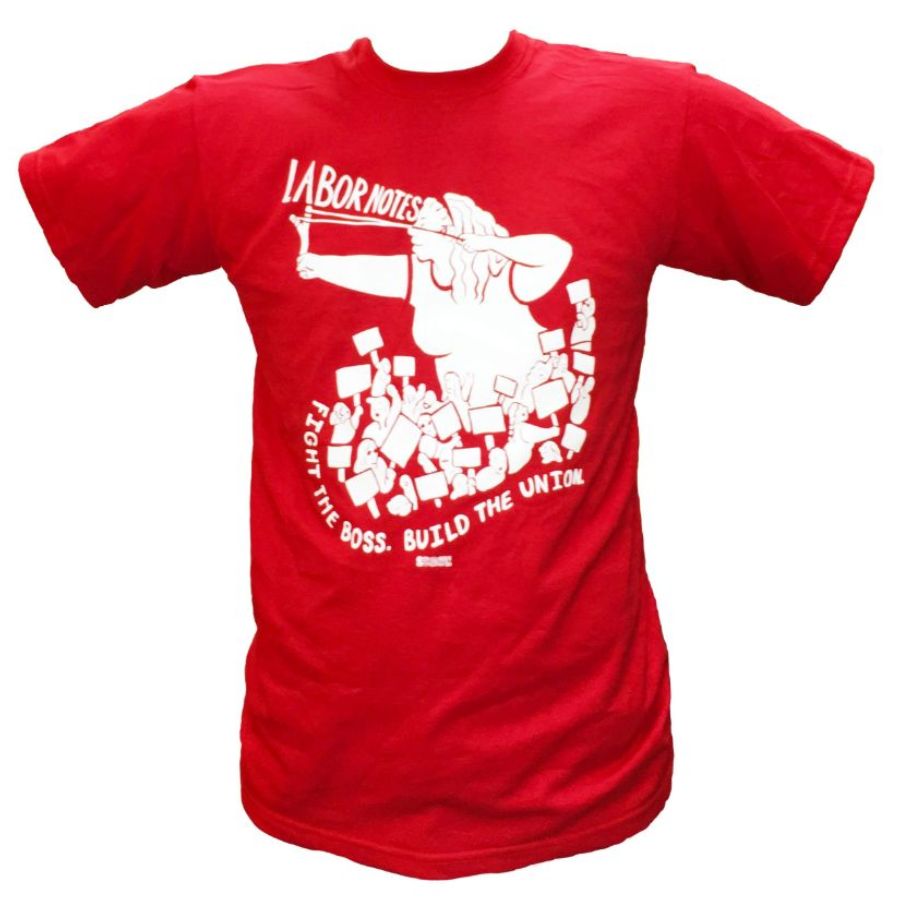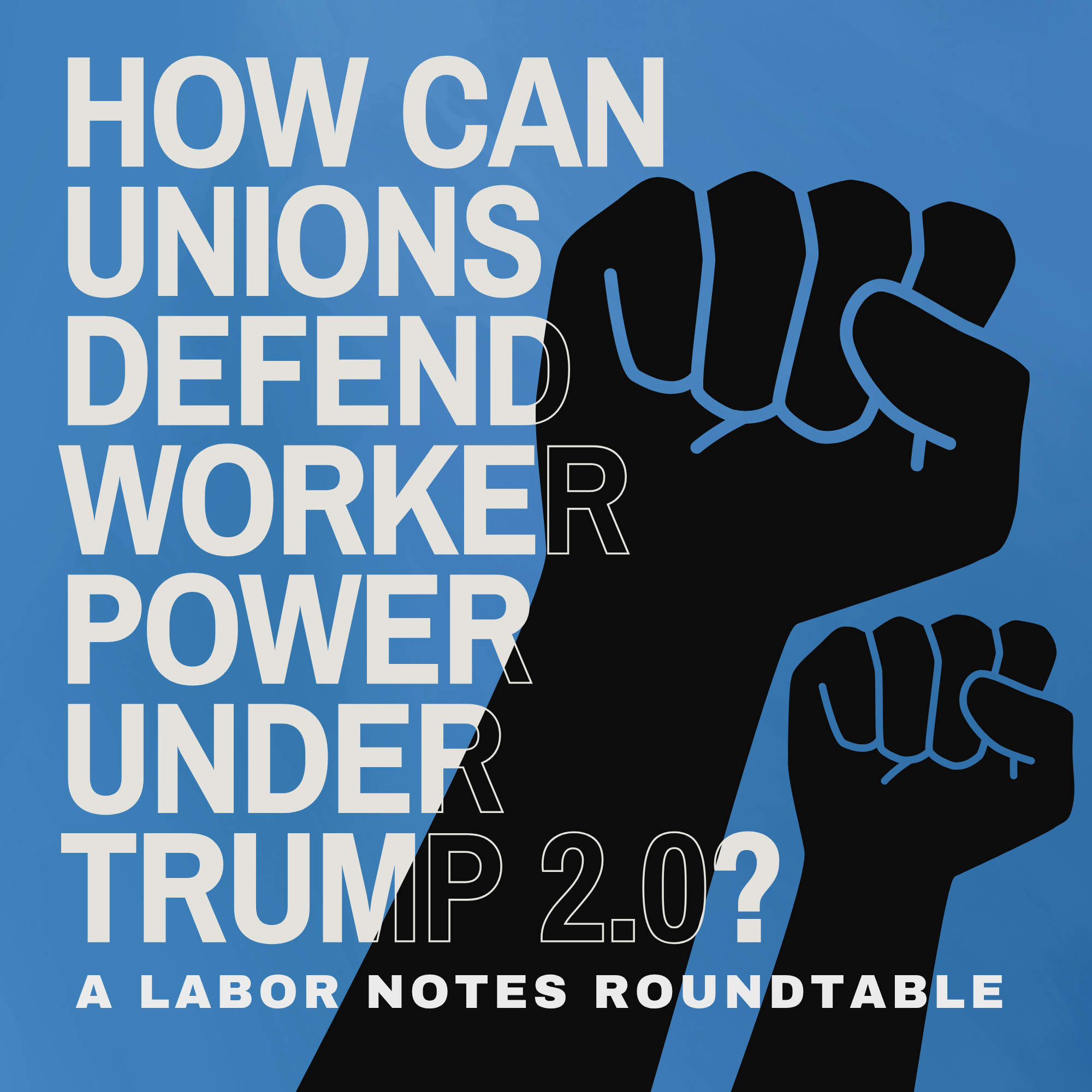We Can’t Rebuild the Labor Movement Without Taking on Big Targets

Difficult as it may be, unions must organize workers in the nation’s largest and most powerful corporations, and they cannot afford to wait for labor law reform or a more favorable administration to do so. Above, members of the Alphabet Workers Union (CWA), which is organizing workers at Google, join Labor Day demonstrations this year. Photo: Alphabet Workers Union
[This article is part of a Labor Notes roundtable series: How Can Unions Defend Worker Power Against Trump 2.0? We will be publishing more contributions here and in our magazine in the months ahead. Click here to read the rest of the series.—Editors]
Last year, U.S. unions cautiously celebrated a turnaround in their organizing fortunes. National Labor Relations Board election win rates had reached 79 percent, and the number of workers organized for the year approached 100,000, the highest number since 2009.
Yet these gains masked a harsher reality for labor, even before the disastrous 2024 elections. For the labor movement to grow, it needs to organize millions of workers each year, not 100,000. Organizing continues to lag in fast-growing, low-density sectors such as personal services, IT, finance, and health care, while union-heavy sectors like government and manufacturing keep shedding jobs.
Many organizing victories of the last few years—including landmark wins at Amazon, Starbucks, REI, and Trader Joe’s—have yet to yield first contracts, as employers refuse to bargain and some go so far as to challenge the legitimacy of the NLRB.
And things have only gotten harder since Trump began his second term, dismantling the regulatory state, detaining and deporting immigrant workers, and stripping a million federal workers of collective bargaining rights.
AVOIDING HARD TARGETS
Starting around the time of the first Trump administration, many unions responded to the increasingly challenging organizing environment by shifting to campaigns for smaller bargaining units in firms and industries less central to the global economy, where unions had more leverage to restrain the employer’s anti-union campaign.
The proportion of union elections has increased in customer-facing industries such as social services, education, digital media, retail and wholesale, and business, professional, and personal services. Although employers in these firms may oppose unions no less fervently than their counterparts in manufacturing or high tech, they are less mobile, and their client and donor relations put more constraints on their ability to engage in blatant union-busting.
Meanwhile, over the past two decades elections in labor’s traditional sectors, such as manufacturing, construction, transportation, and utilities, have dropped at a steeper rate than the decline in employment in these sectors.
The biggest private sector union wins in recent years have been in graduate student units in private universities such as Columbia, MIT, and Cornell. Unions such as IFPTE and OPEIU have set up new nonprofit divisions, focused on organizing advocacy organizations and grant-funded institutions such as museums. Small independent unions, such as the Campaign Workers Guild and United Campaign Workers, have targeted political campaign staff.
Unions have also been running fewer campaigns outside the NLRB process—that is, they’re making less frequent use of tactics like pressing the employer to voluntarily recognize the union if a majority of workers sign petitions or cards, demanding at the bargaining table to expand the union to cover unorganized units of the same employer, or pushing for elections supervised by community organizations rather than the NLRB. Where unions have used these tactics, it has again been mostly in smaller units in the non-profit, media, and service sectors.
COMPREHENSIVE CAMPAIGNS
Each decade from the 1980s to the early 2000s, more employers ran more aggressive campaigns. But according to soon-to-be-published research I conducted with a team of student researchers, during Trump’s first administration, employer campaigns became less intensive, on average, than they had in the past. Union win rates actually increased.

SUPPORT LABOR NOTES
BECOME A MONTHLY DONOR
Give $10 a month or more and get our "Fight the Boss, Build the Union" T-shirt.
That wasn’t because Trump was pro-union—he stacked the NLRB with the typical management-side lawyers every Republican president appoints. It was because unions chose easier targets.
Between 2016 and 2021, employers failed to mount any campaign against the union in 13 percent of NLRB election campaigns—not one letter, leaflet, or captive-audience meeting. Yet, if the elections were weighted to reflect the same types of firms unions were organizing 20 years earlier, unions would actually have faced significantly more intense employer opposition and would have won fewer elections. Most employers continue to fight unions tooth and nail. Unions are increasingly avoiding these fights.
Because union and employer campaigns respond to each other, union campaigns also declined in intensity between 2016 and 2021. Fewer than a quarter had organizing committees representative of the workplace, ran campaigns that engaged community allies, involved other unions or the media, or held rallies and job actions. Even fewer (just 5 percent) mounted global solidarity campaigns or engaged with unions at other branches of the parent company.
Most importantly, even in campaigns where they faced more aggressive employer opposition, most unions continued to pick and choose a few tactics rather than develop a more comprehensive organizing strategy. Comprehensive campaigns systematically deploy a broad range of tactics including strategic research, representative rank-and-file organizing committees, volunteer organizers drawn from the membership, a focus on issues that resonate with workers and the community, escalating actions in the workplace and beyond, the development of leverage via alliances with sympathetic politicians, community organizations, and other unions (in the U.S. and abroad), and preparation for the first contract fight during the organizing campaign. They also provide sufficient staff and financial resources to carry them out.
My past research has shown that comprehensive union organizing campaigns are associated with significantly higher union win rates, even when controlling for employer opposition and the organizing environment—and this continues to be the case today.
CAN’T AFFORD TO WAIT
It should not be surprising that unions are shifting their focus towards the kinds of companies they believe will yield the most success in organizing. Workers in smaller units in the service, retail, and nonprofit sectors need and benefit from unions no less than their counterparts in larger firms in more mobile sectors of the economy.
However, there are costs to this trend. Unions are winning fewer workers, in smaller units, and increasingly those wins are at the margins of the economy. As we have witnessed in the first year of the Trump administration, the world’s largest and wealthiest corporations are increasingly driving our nation's economic and social policies.
Difficult as it may be, unions must organize workers in the nation’s largest and most powerful corporations, and they cannot afford to wait for labor law reform or a more favorable administration to do so.
To build worker power during the second Trump administration, unions will need to learn or relearn how to organize outside the NLRB process and without the benefit of federal government enforcement. And they will need to do it with the same scale and intensity that they used to win major strike victories at the Big 3 automakers, hotel chains, and Hollywood in 2023.
Most importantly, unions will need to leverage the power of workers and their allies, through worker- and community-centered, strategic, multifaceted, and escalating campaigns, to make the cost of fighting the union greater to employers than the cost of recognition and bargaining a fair agreement. It won’t be easy—but taking on corporate power never is.
Kate Bronfenbrenner is the director of labor education research and a lecturer at Cornell University's School of Industrial and Labor Relations. She is a member of the AAUP/AFT Cornell Chapter.





